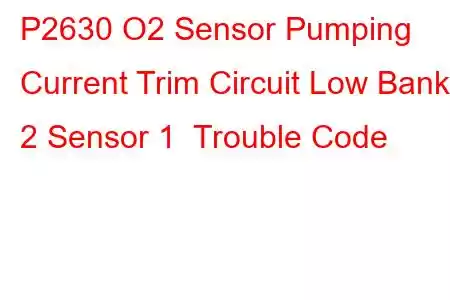P2630 O2 Sensor Pumping Current Trim Circuit Low B2S1
OBD-II Trouble Code Technical Description
O2 Sensor Pumping Current Trim Circuit Low Bank 2 Sensor 1
What does that mean?
This generic powertrain diagnostic trouble code (DTC) typically applies to all OBD-II equipped vehicles, including but not limited to vehicles from Ford, Kia, Hyundai, Mini, Audi, VW, Mercedes, BMW, etc.
The P2630 OBDII trouble code is associated with the O2 Sensor Pumping Current Trim Circuit. When the Powertrain Control Module (PCM) detects a malfunction within the O2 Sensor Pumping Current Trim Circuit for the number one known as the upstream sensor, six different codes can be set.
These codes are P2626, P2627, P2628, P2629, P2630 and P2631 based on the specific signal that alerts the PCM to set the code and illuminate the Check Engine Light.
Code P2630 is set by the PCM when the O2 Sensor Pumping Current Trim Circuit for Bank 2 Sensor 1 is sending a lower voltage signal than normal. Bank 2 is the bank of the engine that does not contain cylinder #1.
What does an O2 sensor do?
The purpose of an O2 sensor is to monitor how much unburned oxygen is in the exhaust when it exits the engine. The PCM uses the signals sent from the O2 sensors to determine the oxygen levels in the exhaust.
These readings are utilized to control the fuel mixture. The PCM will adjust the fuel mixture accordingly when the engine is burning rich (less oxygen) or lean (more oxygen). All OBDII vehicles incorporate a minimum of two O2 sensors, one before the catalytic converter (upstream) and one after (downstream).
An independent dual exhaust configuration will incorporate four O2 sensors. This P2630 code is associated with the upstream sensors located before the catalytic converter (sensor #1).
Code Severity & Symptoms
The severity of this code is moderate, but will progress if not corrected in a timely manner. Symptoms of a P2630 trouble code may include:
Poor performance that progresses The engine will run lean The engine will run rich Check Engine Light illuminated Smoke from tailpipe Increased fuel consumptionCommon Causes Of A P2630 Code
Possible causes of this code may include:
Faulty O2 Sensor Carbon Buildup on O2 Sensor Blown fuse (if applicable) Fuel pressure too high Fuel pressure too low Vacuum leak on the engine Excessive exhaust leak Corroded or damaged connector Faulty or damaged wiring Faulty PCMP2630 Diagnostic and Repair Procedures
Check for TSBs
The first step in the troubleshooting process for any malfunction is to research the Technical Service Bulletins (TSB's) for the specific vehicle by year, model and power plant. In some circumstances this can save a lot of time in the long run by pointing you in the right direction.
The second step is to locate the O2 sensor before the catalytic converter. Perform a thorough visual inspection to check the associated wiring for obvious defects such as scraping, rubbing, bare wires, or burn spots. Next is to check the connector for security, corrosion and damaged pins. With the engine running, the visual inspection should include identifying possible exhaust leaks. Based on the fuel consumption and the engine operation fuel pressure tests may be recommended. You should consult the specific tech data to determine this requirement.
Advanced Steps
The advanced steps become very vehicle specific and require the appropriate advanced equipment to perform accurately. These procedures require a digital multi meter and the specific technical references for the vehicle. Voltage requirements will very based of the specific year, model and engine in the vehicle.
Voltage Checks
When the fuel mixture is balanced at about 14.7 to 1 which is normal for most engines to achieve optimum performance, the sensor will read around 0.45 volt
Read: 27


